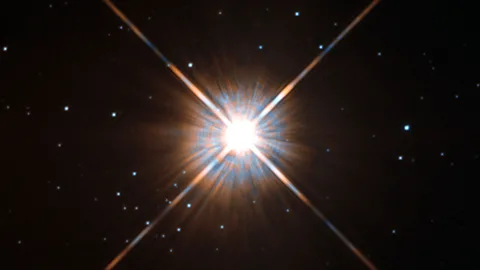- Israel-Gaza War
- War in Ukraine
- US Election
- US & Canada
- UK Politics
- N. Ireland Politics
- Scotland Politics
- Wales Politics
- Latin America
- Middle East
- In Pictures
- Executive Lounge
- Technology of Business
- Women at the Helm
- Future of Business
- Science & Health
- Artificial Intelligence
- AI v the Mind
- Film & TV
- Art & Design
- Entertainment News
- Destinations
- Australia and Pacific
- Caribbean & Bermuda
- Central America
- North America
- South America
- World’s Table
- Culture & Experiences
- The SpeciaList
- Natural Wonders
- Weather & Science
- Climate Solutions
- Sustainable Business
- Green Living

The myths and reality about interstellar travel

Is reaching alien planets outside our Solar System actually possible, and if so, how would it work?
Science fiction writers and moviemakers have shown us countless visions of humanity spread out across the Universe, so you might be forgiven for thinking that we’ve already got this in the bag. Unfortunately, we still have more than a few technical limitations to overcome – like the laws of physics as we understand them – before we can start colonising new worlds beyond our Solar System and galaxy.
That said, several privately funded or volunteer initiatives such as the Tau Zero Foundation , Project Icarus and Breakthrough Starshot have emerged in recent years, each hoping to bring us a little bit closer to reaching across the cosmos. The discovery in August of an Earth-sized planet orbiting our nearest star has also raised fresh hopes about visiting an alien world.
Interstellar spacecraft will be one of the topics discussed at BBC Future’s World-Changing Ideas Summit in Sydney in November . Is travelling to other galaxies possible? And if so, what kinds of spacecraft might we need to achieve it? Read on to get up to (warp) speed:
WHERE WOULD WE GO?
Where wouldn’t we go? There are more stars in the Universe than there are grains of sand on Earth – around 70,000,000,000,000,000,000,000 – and billions of these are estimated to have one to three planets in the so-called ‘Goldilocks’ zone: not too hot, not too cold .
As we’re just starting out, the best contender so far is our nearest stellar neighbour – the triple star system of Alpha Centauri, 4.37 light-years away. This year, astronomers at the European Southern Observatory discovered an Earth-sized planet orbiting Alpha Centauri’s red dwarf star Proxima Centauri . The planet, named Proxima b, is at least 1.3 times the mass of the Earth but has a very tight orbit around Proxima Centauri, taking just 11 Earth days to complete the trip. What has astronomers and exoplanet hunters especially hot under the collar is that this planet is in the right temperature range for liquid water, which is a useful proxy for habitability.

The downside is we don’t know if it has an atmosphere, and given its closeness to Proxima Centauri – closer than the orbit of Mercury around our Sun – it would likely be exposed to dangerous solar flares and radiation. It is also tidally-locked, which means the planet always presents the same face to its star; something that would completely alter our notions of night and day.
HOW WOULD WE GET THERE?
That’s the $64 trillion question.
Upcoming event
The BBC's World-Changing Ideas Summit
This story is part of a series inspired by the subjects and speakers appearing at BBC Future’s World-Changing Ideas Summit in Sydney on 15 November. Find out more about the inspiring people coming to the meeting , including:
- Researcher Rachel Armstrong on organic spacecraft
- BBC TV presenter Michael Mosley on the future of food and health
- Uber’s Kevin Corti on the hidden patterns of transport
- Scientist and TV presenter Emma Johnston on 'blue engineering'
- Astronauts Ron Garan and Andrew Thomas
+ many more

Breakthrough Starshot – a $100 million initiative privately funded by Russian billionaires Yuri and Julia Milner – is focusing on propelling a tiny unmanned probe by hitting its extremely lightweight sail with a powerful Earth-based laser . The idea is that if the spacecraft is small enough – and we’re talking barely a gram – and the sail light enough, the impact of the laser will be enough to gradually accelerate the craft to around one-fifth of the speed of light, taking it to Alpha Centauri in around 20 years.
The Milners are counting on miniaturisation technologies to enable this tiny craft to carry a camera, thrusters, a power supply, communication and navigation equipment so it can report on what it sees as it flashes past Proxima b. Hopefully the news will be good, because that will lay the foundation for the next and more difficult stage of interstellar travel: people-moving.
WHAT ABOUT WARP DRIVE?
Star Trek made it all look so easy, but everything we currently know about the laws of physics tells us that faster-than-light travel – or even travel at the speed of light – is not possible . Not that science is throwing in the towel. Inspired by another propulsion system that has captured the imagine of science fiction creators, Nasa’s Evolutionary Xenon Thruster project is developing an ion engine which is hoped to accelerate a spacecraft to speeds up to 90,000mph (145,000km/h) using only a fraction of the fuel of a conventional rocket .
But even at those speeds, we won’t be getting far out of the Solar System within a single generation of spacefarers. Until we work out how to warp time and space, interstellar travel is going to be a very slow boat to the future. It might even be better to think of that travel period as the end itself, rather than a means to an end.
HOW WOULD WE SURVIVE ON AN INTERSTELLAR VOYAGE?
Warp drives and ion propulsion are all very sexy, but they’re not much use if our interstellar voyagers starve, dehydrate or suffocate long before they even leave our own Solar System. Researcher Rachel Armstrong, who will be presenting at BBC Future’s World-Changing Ideas Summit in Sydney in November, argues we need to start thinking about the ecosystem that interstellar humanity will occupy out there in between the stars. “We’re moving from an industrial view of reality to an ecological view of reality,” she says.

As professor of experimental architecture at the University of Newcastle in the UK, Armstrong talks about ‘worlding’: “it’s about the inhabitation of spaces, not just the design of an iconic object,” she says. The inside of a spacecraft or space-station today is sterile, and industrial, she argues. Armstrong believes we instead need to think ecologically about our vessels – about the vegetation that is grown, and even the kinds of soils we take with us. In the future, she envisages giant biomes, full of organic life, not the cold, metal boxes of today .
CAN'T WE JUST SLEEP ALL THE WAY THERE?
Cryosleep, hibernation or some form of stasis are favoured solutions to the prickly problem of how to keep people alive on a voyage that might take longer than a human lifespan (a subject explored in the upcoming movie Passengers ). A facility full of cryopreserved bodies and heads at the Alcor Life Extension Foundation are testament to human optimism that we will one work out how to safely freeze and thaw humans , but again, no such technology currently exists.
One suggestion, which is explored in movies such as Interstellar and books such as Neal Stephenson’s Seveneves, is to send frozen embryos that could – presumably – survive those hardships by virtue of not needing to eat, drink or breathe. But this raises the very ‘chicken and egg’ problem of who would raise these fledgling humans when they arrive at their destination.
SO, WILL IT ACTUALLY HAPPEN?
Probably not in the lifetime of anyone old enough to read this article, but in the longer term, there’s cause for optimism. “From the outset of human existence we’ve looked up at the stars and projected our hopes and fears, anxieties and dreams there,” says Armstrong. And with the launch of projects to tackle the engineering, such as Breakthrough Starshot, “this is no longer just a dream, this is an experiment now”.
Join 700,000+ Future fans by liking us on Facebook , or follow us on Twitter , Google+ , LinkedIn and Instagram .
If you liked this story, sign up for the weekly bbc.com features newsletter , called “If You Only Read 6 Things This Week”. A handpicked selection of stories from BBC Future, Earth, Culture, Capital, Travel and Autos, delivered to your inbox every Friday.

COMMENTS
Interstellar travel is the hypothetical travel of spacecraft from one star system, solitary star, or planetary system to another. Interstellar travel is expected to prove much more difficult than interplanetary spaceflight due to the vast difference in the scale of the involved distances. Whereas the distance between any two planets in the Solar System is less than 55 astronomical units (AU ...
A Groundbreaking Scientific Discovery Just Gave Humanity the Keys to Interstellar Travel In a first, this warp drive actually obeys the laws of physics.
There's no law of physics that outright forbids interstellar travel. But that doesn't necessarily make it easy, and it certainly doesn't mean we'll achieve it in our lifetimes, let alone this century.
Faster-than-light 'warp speed' interstellar travel now thought to be possible. In another example of how truth is often stranger than fiction, scientists have taken a significant step towards turning the sci-fi concept of "warp drives" into a feasible reality. According to Einstein's theory of relativity, going faster than the speed of ...
Scientists Believe Light Speed Travel Is Possible. Here's How. A functioning warp drive would allow humans to reach the far ends of the cosmos in the blink of an eye.
A Groundbreaking Discovery For Interstellar Travel; How Vacuum Energy Could Help Us Reach Light Speed; Of course, before we can jump into our gamma ray-powered rockets to explore the neighboring ...
Despite the daunting, multipronged challenge of interstellar travel, in 1985, Forward created actual plans for an ultra-light interstellar probe powered by microwave lasers, or masers.
Until we work out how to warp time and space, interstellar travel is going to be a very slow boat to the future.
To understand the difficulty of interstellar travel, one must comprehend the incredible distance involved. Even the closest star is more than 266,000 times farther away than our own sun. Consider ...
Neil deGrasse Tyson Explains Faster Than Light Interstellar Travel Science Time 767K subscribers Subscribe Subscribed 7.7K 492K views 1 year ago #space #universe #science
For the sake of this video, titled "NASA's Guide to Near-light-speed Travel" (shown above), it is assumed that the interstellar traveler (who appears to be an alien creature) has built a spacecraft that is capable at traveling at 90 percent the speed of light (0.9 c). The video is presented as an information video for an interstellar traveler.
Is interstellar travel doomed to remain in the realm of science fiction? Sticking to near future space propulsion only, how close can we get to the speed of ...
Here are some potential ways we Earthlings could achieve interstellar travel, ranked from least to most likely.
Three Ways to Travel at (Nearly) the Speed of Light One hundred years ago today, on May 29, 1919, measurements of a solar eclipse offered verification for Einstein's theory of general relativity. Even before that, Einstein had developed the theory of special relativity, which revolutionized the way we understand light. To this day, it provides guidance on understanding how particles move ...
Interstellar Travel Could Be Possible Even Without Spaceships, Scientist Says. In about 5 billion years, the Sun will leave the main sequence and become a red giant. It'll expand and transform into a glowering, malevolent ball and consume and destroy Mercury, Venus, Earth, and probably Mars.
These New Technologies Could Make Interstellar Travel Real Long considered science fiction, leaving the solar system and speeding amid the stars may soon be within reach By Corey S. Powell Mar 12, 2019 5:00 PMJan 3, 2020 9:49 AM
As is often the case in space travel, developing true interstellar travel like what we see in Star Trek will require significant changes in the cost and energy requirements.
Interstellar travel may be the stuff of science fiction, but it's straightforward to calculate that it should be possible given the ability to travel at a significant fraction of the speed of light.
Interstellar, in one of its most intense scenes, got it right. From our perspective in 3-D space, a wormhole should look like a sphere. Wormholes are an attractive approach to FTL technology ...
2 You can get as close as you want. The usual E=1/2 mv 2 breaks down at relativistic speeds. Instead, you get the famous formula E=mc 2. And as you might know, your mass increases as you approach light speed, by a factor (1-v 2 /c 2) -1/2. In other words, as you approach light speed your mass goes to infinity.
Solar One—part light sail, part laser system, part fusion reactor—can theoretically travel at 22 percent the speed of light.
The technology we (or aliens) need for long-distance interstellar travel There are a few possible solutions to the problem of interstellar travel, but they largely remain within the realm of ...
Interstellar traveling speeds If a space ship is using constant acceleration over interstellar distances, it will approach the speed of light for the middle part of its journey when viewed from the planetary frame of reference. This means that the effects of relativity will become important. The most important effect is that time will appear to pass at different rates in the ship frame and the ...
2 I have theoretical questions about inter-stellar travel at very high speeds (e.g. 0.9c). The inter-stellar medium is not a perfect vacuum, there are about 1 atom per cm 3. This causes some friction. I tried to estimate this and it ended with about 30kW/m 2.
This book covers topics ranging from; light-speed travel and infinite Lorentz factors, nuclear energy applications, wormhole travel, light-sails, the immortality of the soul, astral-planar travel, to chemical rockets.
The impulse of photons would push the starship to a fraction of light speed. Riding a beam of light, a lightsail mission could reach Proxima Centauri in a couple of decades.
Interstellar space is full of magnetic fields, and those fields are constantly fluctuating, deflecting cosmic rays in random directions—sort of like a broken CRT in an old TV that only shows static.
Interstellar's IMAX rerelease wasn't canceled over destroyed prints, despite viral rumors. Stop making your Matthew McConaughey crying face, it's going to be OK
Later in the day, almost certainly because of those rumors, Variety broke the news that the Interstellar re-release was still happening, just on December 6, not September 27.
As Interstellar completes 10 years, the epic science fiction drama by Christopher Nolan gets ready for a re-release in theatres.